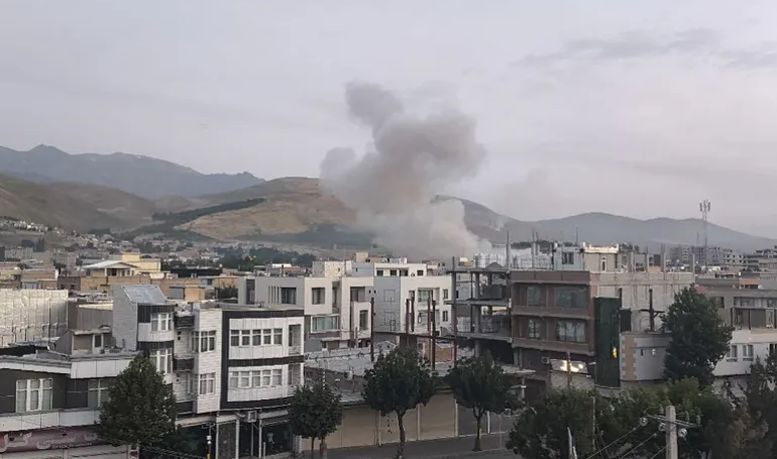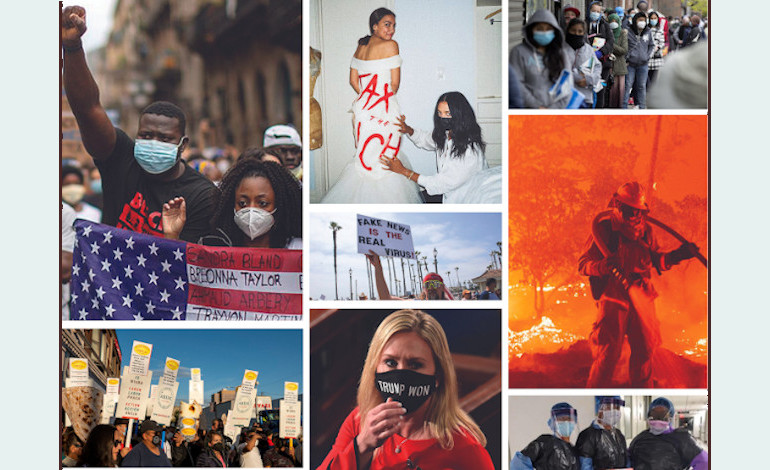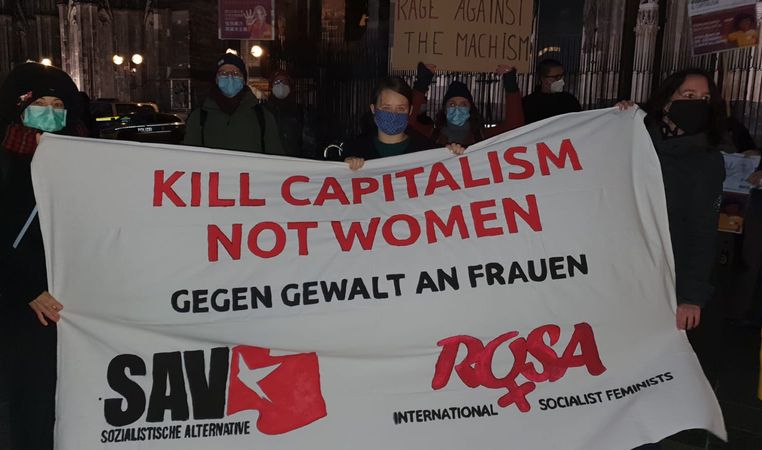Only the working class can stop war — urgent international workers’ action needed to shut down the war machine
The genocidal Israeli regime’s large-scale military attack on Iran may be the beginning of a larger and longer regional war. The working class and poor masses, as well as the region’s reactionary regimes now await the next moves from Tehran and Jerusalem, in fear of devastating and turbulent consequences.
Millions of workers, poor and oppressed people will be the main victims of an escalated war between the murderous Israeli state and the dictatorship in Iran. Repercussions will spread around the globe, further escalating processes of militarization and authoritarianism. It will also have huge economic and political effects.
Against this will stand movements and protests from below, as the strong international movement against the genocidal war on Gaza has shown. Anti-war struggle from the working class in the region and globally will be decisive and is the only way to restrain and stop a wider war, and topple dictatorships and war-mongering governments, which is the only path to a decisive solution. Trade unions should immediately take action against war and militarism, following the example of dock workers in France, Sweden and Italy who recently refused to handle weapons shipments bound for Israel. UN resolutions and hypocritical comments from governments will not stop a war, and we should have no illusions in these institutions taking decisive action.
Netanyahu tries to seize the moment
The attack was a continuation of the terror it has inflicted throughout the region in recent months, and the logical conclusion of Netanyahu’s extreme right-wing government in Israel, which for years has pointed at Iran as its main enemy. Why did it take place now? An important reason is the military weakening of Iran in recent months, especially its “axis of resistance” surrounding Israel. Hezbollah and Hamas have lost most of their fighting capacity following Israel’s military onslaught. The Assad regime in Syria, an ally of Iran, collapsed at the end of last year. In addition, the exchange of missiles between Iran and Israel in April and October last year destroyed much of Iran’s air defences.
For Netanyahu, the recent year has also proved that war and military attacks are means of undermining the official opposition in Israel and bolstering the reactionary nationalist mood in society. His government does not have majority support. Opinion polls have shown that 60–70 percent are in favour of an end of the genocidal war on Gaza and there has been increasing hesitation expressed by reservists alongside critical comments from some former political and military chiefs. This blood-soaked government now hopes that its onslaught against Iran will have a similar effect to its assault on Hezbollah last year which led to a sharp, although temporary, downturn in protests against the government.
The Netanyahu government is full of hubris, strengthened by the support from Trump. In March, it shattered the temporary Gaza “ceasefire” and launched a “total war” for the full occupation of Gaza. It has also carried out the strongest military assaults in the West Bank for a long time. In both cases, this is accompanied by genocidal declarations from ministers openly arguing for ethnic cleansing. At the same time, the Israeli army has established new bases over the border in both Lebanon and Syria, and carried out regular military attacks in both countries. It has also repeatedly attacked Yemen, launching large-scale bombings after Trump declared that US bombings there had ended following a precarious deal between the US and Houthi forces.
The new bombings in Iran are the largest ever Israeli attack, involving 200 fighter jets out of Israel’s reported total fleet of 300. Netanyahu stated this was only the beginning, and in similar language as he used in relation to Gaza, said that attacks will continue until his ultimate goal is reached. This underlines the overreach and hubris of Netanyahu’s government. How events, mass consciousness and protests develop now will depend on Iran’s retaliation and its effects in the region.
The Iranian regime is obviously shaken. Since last year it has attempted to repair its military defence and prepare for an attack. Yet, Israel was now able to attack military facilities as well as residential areas in major cities. Top military leaders were killed, including the chief of the “revolutionary guard” and the head of the army. Six leading nuclear scientists were also killed.
The alleged and fake reason for the attack was the claim by Netanyahu that Iran was “within days” of developing a nuclear bomb. One of the main targets was Natanz, the centre of Iran’s nuclear industry, including uranium-enrichment. This aim contradicts the view expressed by most observers, including recent US intelligence: “…as recently as March, Tulsi Gabbard, America’s director of national intelligence, said that its intelligence agencies had concluded that ‘Iran is not building a nuclear weapon and Supreme leader Ayatollah Ali Khamenei has not authorized the nuclear weapons program that he suspended in 2003’ “ (The Economist).
Region on the edge
Military experts have also long warned that Israel’s air force does not have the capacity needed to reach the underground bases used for nuclear development in Iran. Only the US has sufficient bombs and planes to manage that, and even then, only as the result of a long campaign. “Experts have previously estimated that even America’s largest “bunker-buster” bomb, the GBU-57, which cannot be carried by Israeli warplanes, would need to be used many times on the same point. Israel might have targeted the entrances, tunnels and ventilation shafts of these facilities to put them out of action.” (The Economist). The possible radioactive fallout from such attacks has also not yet been clearly measured.
Trump solidly supports Israel’s government, but has tried to avoid war through talks held in Oman (the next round was planned to take place in Jordan this Sunday). This is linked to pressure from the regimes in the Gulf — Saudi Arabia, UAE, Qatar, Oman — who fear an Iranian response and who have re-established diplomatic links with Tehran in recent years. Trump regards the Saudi regime as key to his plans for Gaza and the region, aiming for a deal between Jerusalem and Riyad. Now, the Saudi regime has, inevitably, strongly condemned Israel’s attack and the talks between US and Iran are most likely permanently derailed. After the failure of his Ukraine diplomacy, this is yet another disastrous calamity for Trump’s hypocritical efforts at “peace making.”
The White House was informed of Israel’s attack but did not take part. The morning after the bombings, Trump appeared to celebrate the attacks, and use them as blackmail to push Tehran into a deal on his terms. He posted on his “Truth Social” platform:
“I told them it would be much worse than anything they know, anticipated, or were told, that the United States makes the best and most lethal military equipment anywhere in the World, BY FAR, and that Israel has a lot of it, with much more to come — And they know how to use it.
Certain Iranian hardliner’s spoke bravely, but they didn’t know what was about to happen. They are all DEAD now, and it will only get worse!”
The dictatorship in Tehran will have little choice but to hit back as hard as they can. In 2019, Iranian missiles destroyed a large part of Saudi Arabia’s oil facilities. Last year’s missile strikes against Israel were relatively limited but the destruction caused, especially at one military airport, was larger than Israeli authorities admitted. This time, attacks could also be targeted at oil shipments in the Gulf. Indeed, the risk of this taking place caused an immediate sharp rise in oil prices within hours of Israel’s bombings. Less likely, but also not excluded are Iranian attacks against US military bases in Iraq, Qatar and Oman.
The regime in Iran has been shaken by large movements from below several times in recent years. In 2022, the “Woman, life, freedom” protests became a mass movement of women and youth, linking up with oppressed nationalities and workers’ struggles. Teachers, bus drivers and others have also organized strikes and struggles since then. Most recently, truck drivers have been on strike in more than 130 cities.
The regime will not be overthrown by Israel or the US. On the contrary, the regime can use war for its propaganda and to further step up repression internally. The task of the working class in Iran is to struggle against the regime, for democratic rights and against exploitation and economic crisis. This must be an internationalist and socialist struggle, against the Iranian regime as well as against imperialism. The regime is also closely aligned with the China-Russia imperialist bloc. Tehran should not be seen by anyone opposing the Israeli state’s genocidal actions as a force which is genuinely fighting for the oppressed against the US or Israel.
A number of factors will decide how far the war will develop. Most probable in the coming days and weeks is continued Israeli attacks on Iran, with Tehran retaliating. Further developments remain to be seen. It should be borne in mind that other recent wars have all lasted longer than most expected.
The world has become even more dangerous, with fear of even greater wars as conflict spreads. Trump and Netanyahu have lowered the threshold for new wars, and together with Putin and the Ukraine war turbo-charged militarism and a new arms race. For socialists, workers and anti-war activists this proves the need for consistent and organized international struggle against war and militarism, and the system of capitalism and imperialism that is breeding them, for an alternative of peace and international socialism.




